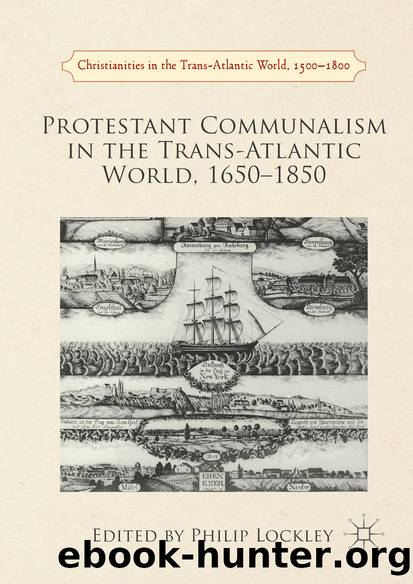Protestant Communalism in the Trans-Atlantic World, 1650â1850 by Philip Lockley

Author:Philip Lockley
Language: eng
Format: epub
Publisher: Palgrave Macmillan UK, London
George Rapp: From Pietist to Separatist
As a young man in his early twenties, George Rapp travelled for a couple of years, probably working as a linen weaver, a trade which he had adopted like so many others to supplement his income from farming. Unfortunately, we do not know where Rapp went on his travels or whom he met, but it is very likely that he adopted some of the new religious ideas of radical separatist Pietism at this time.12 Later, Rapp revealed an intimate knowledge of the writings of Jakob Böhme (1575â1624), the mystic shoemaker from Silesia in eastern Germany.13 Böhme had combined interests in philosophy, alchemy, mysticism and the Jewish kabbala, and must have read widely in these fields. His thought covered theology, cosmology and anthropology. In his own letters, Rapp would handle Böhmeâs mystic and alchemistic terminology without difficulty.
When Rapp returned home from his travels and settled back in his native village he married Christine Benzinger, and the couple had two children. Rapp did not develop his new religious ideas right away, but after some years he started staying away from church services and especially from communion. When Rapp was questioned in 1785 by the Iptingen Kirchenkonvent, the local body of elders, as to why he did not attend church, he said that Christ had revealed himself to him in his heart so he did not have to come to church any longer. On further questioning he answered that as Jesus was enshrined in his heart he did not believe he needed the external means of salvation like sermons and sacraments.
Rappâs opinions were typical of separatist Pietism in his period, and were not an unusual form of religious protest. Yet Rapp clearly gained notoriety and a position of leadership, as his example was soon followed by many others, who came to him from all over the surrounding region. Rapp began to hold religious gatherings outside of official church services, even though people knew they should not travel across country to such meetings. One protest quickly led to another. Rappâs followers refused to bring their children to be baptized, did not send their children to school and did not have them confirmed. Most disturbingly for the Württemberg authorities, they refused to give the oath of allegiance owed to the prince at every manâs coming of age. All these protests amounted to a radical withdrawal from the accepted standards of established society.
First local then government authorities realized they would have to deal with Rappâs case, though for some time government officials, influenced by the principles of tolerance and freedom of conscience encouraged by the Enlightenment, had become quite lenient in religious affairs.14 Rappâs case was not settled for two years, as officials hoped simply to keep peace and order. This situation changed drastically, however, after the French Revolution. At this time, the authorities in Württemberg, like many other parts of Europe, suddenly became wary of any civil disobedience in their own country. By 1791, Rapp and his followers were threatened with expulsion from the country if they would not stop disdaining the church and its rites.
Download
This site does not store any files on its server. We only index and link to content provided by other sites. Please contact the content providers to delete copyright contents if any and email us, we'll remove relevant links or contents immediately.
| Africa | Americas |
| Arctic & Antarctica | Asia |
| Australia & Oceania | Europe |
| Middle East | Russia |
| United States | World |
| Ancient Civilizations | Military |
| Historical Study & Educational Resources |
Magic and Divination in Early Islam by Emilie Savage-Smith;(1500)
Ambition and Desire: The Dangerous Life of Josephine Bonaparte by Kate Williams(1344)
Bohemians, Bootleggers, Flappers, and Swells: The Best of Early Vanity Fair by Bohemians Bootleggers Flappers & Swells- The Best of Early Vanity Fair (epub)(1343)
Papillon by Henry Charrière(1309)
Twelve Caesars by Mary Beard(1256)
Operation Vengeance: The Astonishing Aerial Ambush That Changed World War II by Dan Hampton(1135)
What Really Happened: The Death of Hitler by Robert J. Hutchinson(1128)
London in the Twentieth Century by Jerry White(1112)
Time of the Magicians by Wolfram Eilenberger(1088)
The Japanese by Christopher Harding(1086)
Twilight of the Gods by Ian W. Toll(1084)
Lenin: A Biography by Robert Service(1045)
The Devil You Know by Charles M. Blow(985)
A Social History of the Media by Peter Burke & Peter Burke(936)
Freemasons for Dummies by Hodapp Christopher;(922)
Napolean Hill Collection by Napoleon Hill(902)
Henry III by David Carpenter;(891)
The Churchill Complex by Ian Buruma(881)
The Rise and Triumph of the Modern Self by Unknown(878)
